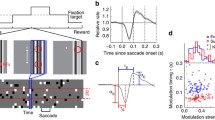Summary
Neurophysiological data from single cells in the monkey's visual association cortex as well as saccadic reaction time measurements in monkey and man are reported. When a monkey directs his attention to a peripheral light stimulus the visual activation of cortical cells responsive to that stimulus is increased. If visual attention is directed to a particular part of the visual field the saccadic reaction time is long (around 200 ms in monkey and above 200 ms in man). In contrast, if attention is disengaged from any location to which it might have been engaged before, monkeys and men can execute express saccades, that is, saccades after extremely short and stable reaction times (around 75 ms in monkey and 100 ms in man). The results are interpreted in the context of a hypothesis according to which the initiation of voluntary, visually guided saccades includes three premotor mechanisms: the computation of the target location, the decision to make a saccade, and the disengagement of attention.
Similar content being viewed by others
References
Bach, M., Bouis, D., & Fischer, B. (1983). An accurate and linear infrared oculometer. Journal of Neuroscience Methods, 9, 9–14.
Becker, W., & Juergens, R. (1979). An analysis of the saccadic system by means of double step stimuli. Vision Research, 19, 967–983.
Boch, R., & Fischer, B. (1983). Saccadic reaction times and activation of prelunate cortex: Parallel observations in trained rhesus monkeys. Experimental Brain Research, 50, 201–210.
Boch, R., Fischer, B., & Ramsperger, E. (1984). Express-saccades of the monkey: Reaction times versus intensity, size, duration, and eccentricity of their targets. Experimental Brain Research, 55, 223–231.
Bruce, C. J., & Goldberg, M. E. (1984). Physiology of the frontal eye fields. Trends in Neurosciences, 7, 436–441.
Bushnell, M. C., Goldberg, M. E., & Robinson, D. L. (1981). Behavioral enhancement of visual responses in monkey cerebral cortex. I. Modulation in posterior parietal cortex related to selective visual attention. Journal of Neurophysiology, 46, 755–772.
Fischer, B., & Boch, R. (1981a). Enhanced activation of neurons in prelunate cortex before visually guided saccades of trained rhesus monkeys. Experimental Brain Research, 44, 129–137.
Fischer, B., & Boch, R. (1981b). Selection of visual targets activates prelunate cortical cells in trained rhesus monkeys. Experimental Brain Research, 41, 431–433.
Fischer, B., & Boch, R. (1983). Saccadic eye movements after extremely short reaction times in the monkey. Brain Research, 260, 21–26.
Fischer, B., & Boch, R. (1985). Peripheral attention versus central fixation: Modulation of the visual activity of prelunate cortical cells of the rhesus monkey. Brain Research, 345, 111–123.
Fischer, B., Boch, R., & Ramsperger, E. (1984). Express-saccades of the monkey: Effects of daily training on probability of occurrence and reaction time. Experimental Brain Research, 55, 232–242.
Fischer, B., & Ramsperger, E. (1984). Human express-saccades: extremely short reaction times of goal directed eye movements. Experimental Brain Research, 57, 191–195.
Goldberg, M. E., & Bruce, C. J. (1981). Frontal eye fields in the monkey: Eye movements remap the effective coordinates of visual stimuli. Neuroscience Abstracts, 44, 4–131.
Guitton, D., Buchtel, H. A., & Douglas, R. M. (1985). Frontal lobe lesions in man cause difficulties in suppressing reflexive glances and in generating goal-directed saccades. Experimental Brain Research, 58, 455–472.
Lynch, J. C., Mountcastle, V. B., Talbot, W. H., & Yin, T. C. T. (1977). Parietal lobe mechanisms for directed visual attention. Journal of Neurophysiology, 40, 362–389.
Posner, M. I., Walker, J. A., Friedrich, F. J., & Rafal, R. D. (1984). Effects of parietal injury on covert orienting of attention. Journal of Neuroscience, 4, 1863–1874.
Robinson, D. L., Goldberg, M. E., & Stanton, G. B. (1978). Parietal association cortex in the primate: Sensory mechanisms and behavioral modulations. Journal of Neurophysiology, 41, 910–932.
Sandell, J. H., Schiller, P. H., & Maunsell, J. H. R. (1984). The effect of superior colliculus and frontal eye field lesions on saccadic latency in the monkey. Perception, 13, A6.
Saslow, M. G. (1967). Effects of components of displacement-step stimuli upon latency of saccadic eye movements. Journal of the Optical Society of America, 57, 1024–1029.
Schiller, P. H., True, S. D., & Conway, J. L. (1980). Deficits in eye movements following frontal eye-field and superior colliculus ablations. Journal of Neurophysiology, 44, 1175–1189.
Shibutani, H., Sakata, H., & Hyvärinen, J. (1984). Saccade and blinking evoked by microstimulation of the posterior parietal association cortex of the monkey. Experimental Brain Research, 55, 1–8.
Sparks, D. L., & Mays, L. E. (1983). Spatial localization of saccade targets. I. Compensation for stimulation-induced perturbations in eye position. Journal of Neurophysiology, 49, 45–63.
Sparks, D. L., & Porter, J. D. (1983). Spatial localization of saccade targets. II. Activity of superior colliculus neurons preceding compensatory saccades. Journal of Neurophysiology, 49, 64–74.
Wurtz, R. H., & Albano, J. E. (1980). Visual-motor function of the primate superior colliculus. Annual Review of Neuroscience, 3, 189–226.
Wurtz, R. H., Goldberg, M. E., & Robinson, D. L. (1980). Behavioral modulation of visual responses in the monkey: stimulus selection for attention and movement. Progress in Psychobiology, Physiology and Psychology, 9, 43–83.
Author information
Authors and Affiliations
Rights and permissions
About this article
Cite this article
Fischer, B. The role of attention in the preparation of visually guided eye movements in monkey and man. Psychol. Res 48, 251–257 (1986). https://doi.org/10.1007/BF00309089
Issue Date:
DOI: https://doi.org/10.1007/BF00309089




